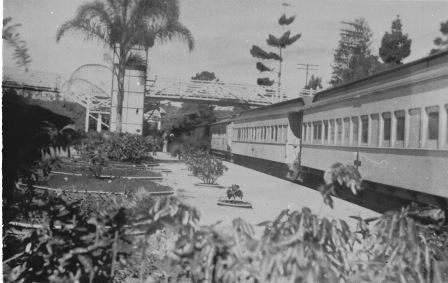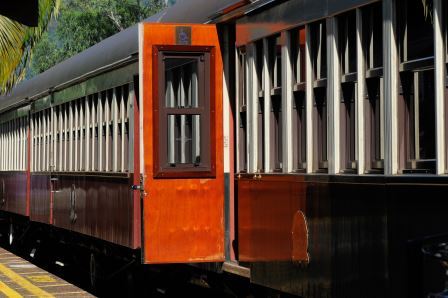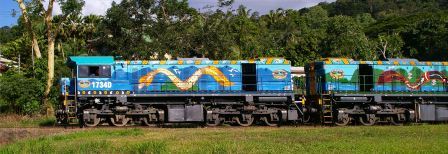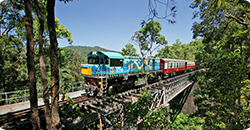Do you consider yourself a train buff? Kuranda Scenic Railway carriages and locomotives have a long and storied history throughout the 20th century. Read on to find out detailed information on the history, design and statistics of our historic railway.
Carriages
Both consists comprise heritage style carriages. The first and last carriage on each service has a Guards' compartment fitted. This style of coach was well known because of their vintage appearance. Such things as open-end verandahs, sun shades over the windows and short wheelbases were common place. As you can imagine, they have been modified and upgraded at various times during workshop maintenance and rebuild programs.
Before leaving the rolling stock, mention must be made of four special carriages that were unique to the Cairns area and may have been the only vehicles of their type to operate in Australia. They were known as “Grandstand” cars and were provided specifically for use by tourists on the train to Kuranda, highlighting the importance placed on this fast growing industry in the North.
 The carriages were first class and had a capacity of 42 passengers. They were numbered 506, 507, 533 and 534. Nos 506 and 507 had originally been built at Ipswich in 1909 to 1910. Nos 533 and 534 were built at Ipswich in 1909. They had identical exterior design but different internal seating classes, being of first and second-class arrangements.
The carriages were first class and had a capacity of 42 passengers. They were numbered 506, 507, 533 and 534. Nos 506 and 507 had originally been built at Ipswich in 1909 to 1910. Nos 533 and 534 were built at Ipswich in 1909. They had identical exterior design but different internal seating classes, being of first and second-class arrangements.
In 1936 Nos 506, 507 and 533 were completely rebuilt at the Ipswich Workshops. During the rebuild large 3'6 scenic glass windows along one side of the carriage, a lavatory at one end and two rows of longitudinal tiered seating were fitted allowing passengers an unrestricted view of the rainforest, gorge and coastal plains skirted by the Coral Seas' of the South Pacific Ocean on the climb up the Kuranda Range.
Carriage No 507 was fitted with a small commentary cabinet at one end combined with a public address system throughout the other carriages. A running commentary of the surrounding attractions was provided on the journey. The carriages were normally run in a three car set combination with an additional conventional carriage, normally No 440 attached. The train was known as the “Grandstand Train” and proved so popular that in 1938, a further “Grandstand” carriage No 534 was provided.
There was a change in the wind with the declaration of WW II. The war stopped all tourist activities in the area. These carriages were changed to suit the needs of the nation for WW II. They were converted into much needed ambulance carriages that formed part of the Australian Ambulance Trains (AAT) that ran in Queensland.

The AAT comprised 13 carriages and operated out of Ipswich. The five Australian Ambulance Trains were used to transport seriously wounded and extremely sick Allied servicemen from the northern tropics of Queensland to the south from 1942. The average trip from Townsville to Brisbane took 48 hours, with the train reaching a top speed of about 35mph (56km/h). More locally it took even longer when from March, 1943, an AAT was operating out of Rocky Creek, Atherton Tablelands, where a group of military hospitals were established to cope with the influx of wounded and diseased Diggers and United States military personnel.
It should be noted here that there was no highway from Cairns to Brisbane at this time and medicos faced serious problems when it came to evacuation of thousands of wounded and sick servicemen returning from the battlefields in New Guinea and other islands in the southwest Pacific. After the war all four carriages were converted to conventional carriages.
Locomotives
 The locomotive power at the head of the train today is a 1720 Class Diesel Electric Locomotive. This class was introduced to traffic in October 1966 and was built by Clyde Engineering Company under license from General Motors USA and subcontracted to Commonwealth Engineering in Brisbane.
The locomotive power at the head of the train today is a 1720 Class Diesel Electric Locomotive. This class was introduced to traffic in October 1966 and was built by Clyde Engineering Company under license from General Motors USA and subcontracted to Commonwealth Engineering in Brisbane.
A total of 56 locomotives were built with the last unit entering service by the end of 1969. Each unit was numbered consecutively from 1720 through to 1775.
A 1000 HP is generated by the units' diesel engine, Model 8- 645E. It is a two-stroke V8 General Motors Engine that has solid fuel injection with blower scavenging. The engine operates at speeds from 315 rpm to 900 rpm.This mechanical power is then converted to electricity by its Main Generator, Model D25E, to high voltage direct current for use in propelling the locomotive.
An Auxiliary Generator converts a small amount of engine power to low voltage power for use in charging the locomotives battery, exciting the main generator, operating the controls, locomotive lights and accessories.
The locomotive is equipped with a Gardner-Denver 3 cylinder, two stage, Model WXE, air compressor that is driven off the main engine. Output of compressed air is 199 cubic feet per minute at 900 rpm. This air is used for operation of the Westinghouse brake system, sanding equipment, warning horn, windscreen wipers and crew vigilance equipment.
The locomotive is relatively lightweight, a total of approximately 60 ton with an approximate 10-ton axle load. This allowed Queensland Rail to operate them on lightweight branch line or suburban passenger train services. The 1720s' operate throughout most of Queensland Rail's extensive rail network and with the passing of time, this class of locomotive has truly earned its place in the top performers division, in regards to locomotive rolling stock.